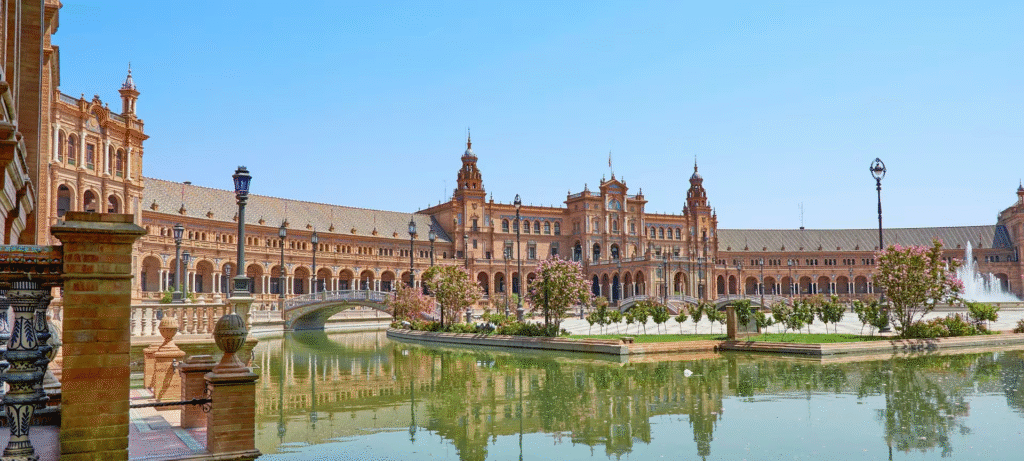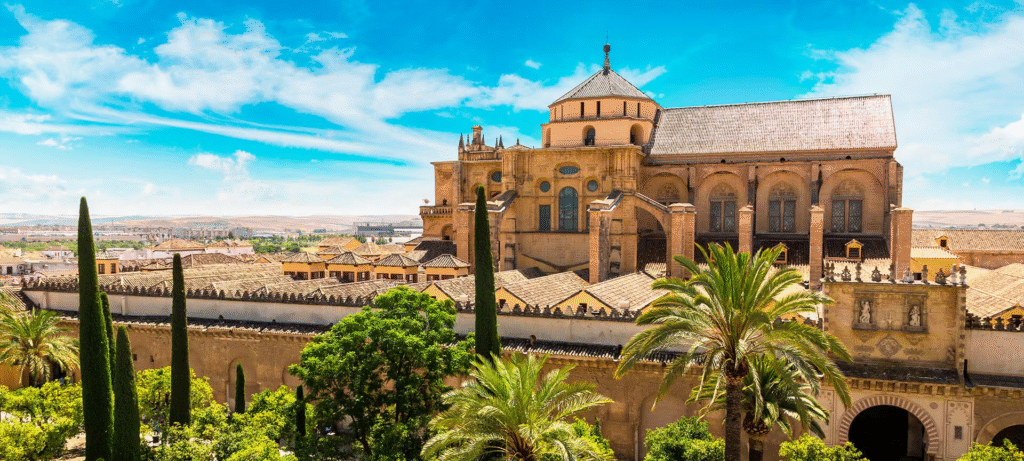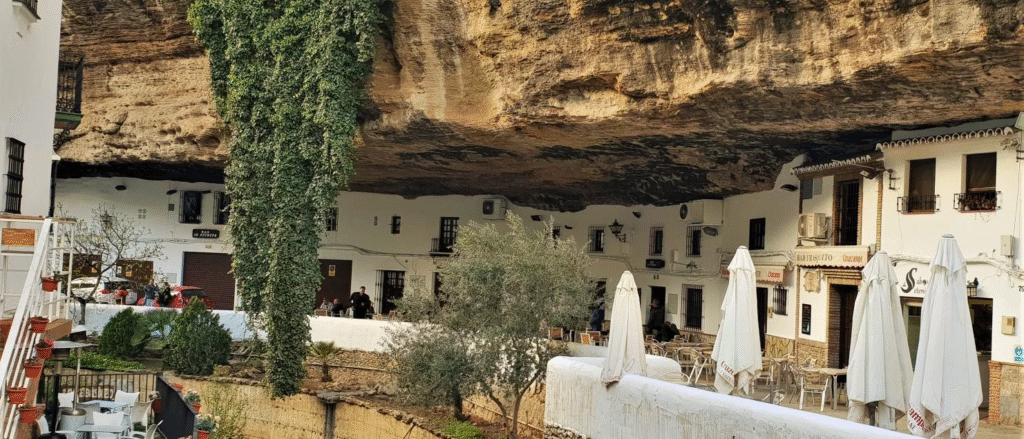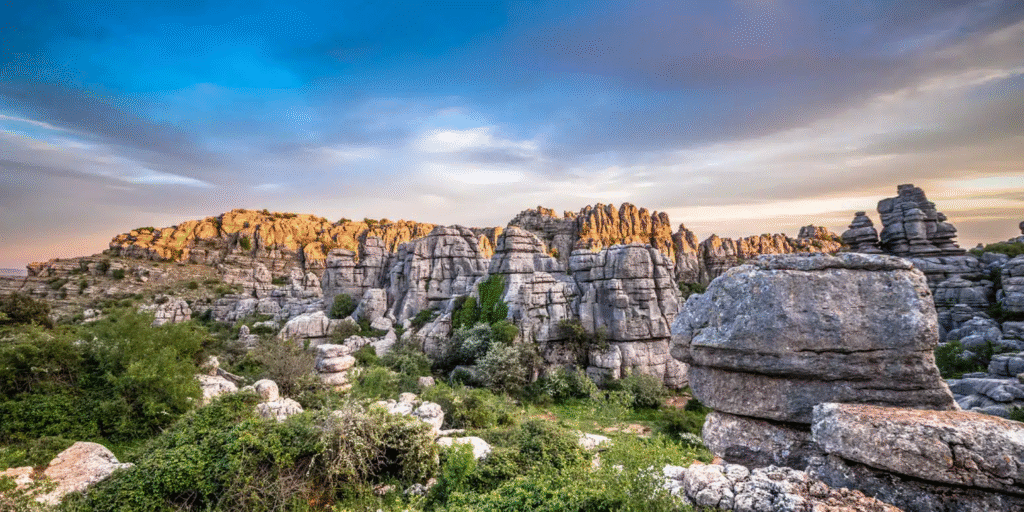Spain has 17 autonomous regions, and Andalusia is the biggest of all. With over 340 days of sunshine a year on average and a culture full of adventures, it may be hard to figure out what to do in Andalusia Spain. Whoever you ask where the most vibrant region in Spain is, you will surely hear Andalusia’s name in the top 3 list.
Check this article out, too: Hot Springs in Norway: Top Hot Springs in Norway
Andalusia is also the only European region with a Mediterranean and Atlantic coastline. That means in one week, you can surf the wild waves of Tarifa and then chill on a beach in Nerja. This region is also bigger than some European countries, like the Netherlands or Belgium. It covers Spain’s most iconic sites like Seville, Granada, and Cordoba. Let me walk you through briefly on what to do in Andalusia Spain. What cities to cities, what activities to plan for, what to eat, what to dance, where to take pictures, and many others.

Introduction to Andalusia’s Treasures
In Andalusia, you will get everything you want in a holiday destination. Beaches to sleep in and do nothing? Yes. Historical sights, ancient traditions, and beautiful architecture? Yes, yes, and yes. Andalusia brings Roman aqueducts, Moorish tilework, and Gothic cathedrals tower over tapas bars. It’s Europe’s cultural cocktail with 1,300 years of layered history.
All of these treasures are also in different cities and different places. It may sound weird, but that’s what makes it fun. Rent a car (or even use a train, up to you) and see different cities in a week. 7 days, 7 cities! But spend at least 3 days in Seville. That’s an ‘extra.’ I’ll start with breaking down Andalusia city by city and take you to each good one.
A Journey Through Andalusian Cities
There are 56 cities in Andalusia with population above 25,000. That’s a lot; as you can imagine, I can’t cover all of them. Plus, not all are worth the visit (not that they are bad, but you can spend your time better in a different city). If you are looking for city-hop ideas when thinking of what to do in Andalusia Spain (which you should), you must know the most important and beautiful cities.
Seville
Seville is Andalusia’s cultural capital. If you want to see Andalusia, you should take Seville as your base. Most cities in Andalusia are a few hours away from here, maximum. It’s also Spain’s fourth largest city, so you have a ton of things to do. I will not go deep here because I have a lot of articles on what to do in Seville and several different itineraries. You can check them.
A couple of important things is that there are very interesting historical sights and Flamenco dance was born here. The Cathedral is the world’s largest Gothic Cathedral, and Columbus’s tomb is in this city. Game of Thrones also shot some scenes and episodes at the Real Alcazar. There are high-speed trains and comfortable buses to all the major and smaller cities in Andalusia from Seville.

Granada
Granada is probably the most magical city in Spain. The first thing you’ll want to do in Granada is to see the Alhambra. It’s a sprawling palace-fortress that sees the city. But Granada has more stuff than UNESCO World Heritage Sites. It’s famous for its student population and is known as a student city. As you can imagine, the energy is there. Nightlife, drinks, food, and beautiful views are combined. The Sierra Nevada is also here, and you must take several pictures here at sunset or sunrise.
Getting from Seville to Granada is probably the longest within Andalusia. Takes about 3 hours by train or by bus. You may want to spend a night here because it takes a bit longer. If you feel energetic, trains and buses run often. You can take an early ride to the city and come back late to Seville. You must go to the Albaicín for sunset views and see a flamenco show in the caves of Sacromonte.

Córdoba
Compared to cities like Malaga, Granada, and Seville, Cordoba is a bit smaller. Which is better, you can spend much more time in the historical sights, events, and under the sun. The Mezquita is the headliner here, a mosque-turned-cathedral. One minute, you’re staring at Islamic arches; the next, you’re under a Renaissance dome. It’s wild. Beyond the Mezquita, the city has a quiet charm. Walk through the flower-filled patios in spring or summer. Explore the old Jewish quarter or cross the Roman bridge at sunset for good views and pictures. The good thing about Cordoba is that you can get from Seville to Córdoba in under 45 minutes by high-speed train.

Málaga
Malaga is the city beach lovers go to. It is one of the biggest cities in Andalusia. You can also take Malaga as your base instead of Seville if you want to be close to the beach. The city is full of beach life and its culture. Malaga is the perfect city to have that laid-back Spanish life with a beach. In addition to the beach and the water, Malaga is the birthplace of Picasso. Understandably, it’s home to a cool art scene, including the Pompidou and a bunch of smaller galleries. Alcazaba is good for some Moorish vibes if you want more historical vibes. You can get some killer seafood at the port. Go there for dinner. Pick a local favorite restaurant, though, not the touristy ones. It takes 2 hours by train to go to Malaga from Seville. Great weekend getaway.

Cadiz
Cadiz is another port city. However, it’s much smaller than Malaga. According to the city itself, Cadiz is the oldest continuously inhabited place in Western Europe. You can imagine that it’s a bit of a historical city. The old town is a maze of alleys, colorful balconies, and shows of history. It takes two hours to get to Cadiz from Seville by train. La Caleta beach is the most popular beach if you want to visit Cadiz for that. Great beach but can be crowded. Go to Mercado Central to get some fried fish in a cone for lunch after your beach break.

Other Must-See Andalusian Cities
The list goes on. I detailed the most important cities but there are many more. Ronda, Marbella, Ubeda, or Baeza. You must pick which one you like and go there. Some of the interesting ones:
- Úbeda – A Renaissance beauty with cobbled streets, sandstone churches, and a lot more architectural stuff than you’d expect from a small inland town.
- Baeza – Neighbor to Úbeda and just as charming. It’s quiet, clean, and full of stunning churches and sunny plazas.
- Carmona – Just a short hop from Seville, this place feels like a movie set with its Roman ruins and killer views over the plains. Easy to do as a half-day trip.
- Osuna – A historic little town with baroque buildings, a bullring, and a side of Game of Thrones street cred (yes, they filmed here).
- Antequera – This one’s for the history nerds. Ancient dolmens, Moorish forts, and a nature park full of weird rock formations.
- Nerja – Nerja is known for its epic sea views and famous caves. It’s a coastal break from the heat with a beach town vibe. Kind of like Malaga but way smaller.
- Frigiliana – Here is often voted one of the prettiest villages in Spain. It’s all steep streets, flowerpots, and mountain and sea views.
Visit Andalusia’s Historical Landmarks and UNESCO World Heritage Sites
Once you pick the cities to visit, the next step is generally to visit the historical landmarks. Most of the historical sites in Andalusia are also UNESCO World Heritage Sites. There are eight of them in total. This number is more than some countries’ total UNESCO sites. Now, there are hundreds of historical sites you need to see. I can’t possibly mention them all, like the cities. That’s why I picked some that you must see:
- The Alhambra Palace and Fortress in Granada – This palace has three different places to see: Alhambra, Generalife, and Albayzin. The palace itself has an Islamic architecture, and the gardens are the Generalife. They are what makes this palace originally a summer palace. There are fountains, arches, and tranquility. Albayzin is the old Moorish quarter of Granada. Full of whitewashed houses and alleys.
- Seville Cathedral – One of the largest Gothic churches in the world, home to Columbus’s tomb and gold altars.
- Real Alcázar of Seville – A royal palace still in use today. Moorish tiles, gardens, and ceilings that look like they were designed by wizards.
- Archivo de Indias in Seville – A massive archive holding centuries of documents about Spain’s colonial adventures. History nerd heaven.
- Renaissance Ensembles of Úbeda and Baeza – Small towns with big architecture. Think Italian-style plazas, elegant churches, and peaceful streets.
- Antequera Dolmens Site – Prehistoric burial sites older than the pyramids. Massive stones and mystery included.
- Medina Azahara near Córdoba – Ruins of a luxurious 10th-century palace city. Didn’t last long, but what’s left is still impressive.

Explore the White Villages
The “pueblos blancos,” aka White Villages, are the Instagram-famous villages of Southern Spain, not just Andalusia. As the name suggests, these villages are full of white houses, and in this place, time stands still. Over 20 of these villages are scattered mostly across the Sierra de Grazalema and along the White Village Route. All of these have narrow, cobbled streets, whitewashed houses, and that small-town vibe that makes you forget what day it is. These villages used lime paint to reflect the heat, but now they’re also reflecting some serious travel envy.
Here are some white villages worth pulling over for:
- Arcos de la Frontera – This village is on a cliff with a killer panoramic view. This village is often the first stop on the White Village trail. Expect winding alleys, quiet plazas, and serious charm.
- Grazalema – Grazalema is in a natural park. If you like hiking, dramatic mountain backdrops, and fresh mountain air, definitely go here. Bonus: fewer tourists.
- Zahara de la Sierra – With a castle on top and a turquoise reservoir below, Zahara looks like someone built it just to win at Instagram.
- Setenil de las Bodegas – This one’s wild. Houses are built into giant rock overhangs. Like, the rock is literally the roof. It’s a geological fun village.
- Mijas Pueblo – Closer to the coast, this one’s got art galleries, donkey taxis (yes, really), and sea views. A bit more polished but still photogenic as ever.
- Vejer de la Frontera – Bohemian, breezy, and full of hidden corners. Come for the food scene, stay for the sunsets.

Natural Parks and Landscapes
In addition to the great cities, cathedrals, white villages, and city streets, Andalusia is full of natural parks and landscapes. Great for hikes, camping, resting, and just whatever you feel like in nature. Here are a few of the important and standout spots to start your nature journey in Andalusia:
- Doñana National Park – A UNESCO-listed wetland wonderland. It’s a big natural park with flamingos and wild horses, and it’s one of the last habitats of the Iberian lynx. It’s home to 300 different bird species. Great for birdwatchers and people who like their nature with some animal kingdom drama.
- El Torcal de Antequera – This place is amazing. It feels like a whole another planet. This spot’s highlight is the weird rock formations (150-year-old seabed formations). You’ll see them everywhere, some big and some small. You’ll find a lot of other natural stuff as you walk around that doesn’t look natural but it is.
- Sierra de Grazalema Natural Park – Home to some of the highest rainfall in Spain (yes, really) and also some of the best hikes. Dense forests, deep gorges, and cute white villages like Grazalema in the hills. With the dense forest, you will also see magnificent waterfalls (like those in Switzerland or Austria).
- Sierra Nevada National Park – Want snow in Spain? This is your spot in winter. Cold weather and a lot of snow. This park is home to mainland Spain’s highest peaks and a solid ski scene in winter. In summer, it’s all about alpine hiking and sweeping views. Sierra Nevada Park is also extremely popular. There may be more tourists than other parks.
- Cabo de Gata-Níjar Natural Park – Wild beaches, volcanic cliffs, and a feeling of doomsday Earth. It’s dry, rugged, and completely unspoiled. A different kind of Andalusia.

Active Adventures and Scenic Hikes
Did you like the nature Andalusia offers? Do you want to do more and explore more of this side of Andalusia? Well, you can. There are a ton of other things you can do out there in the nature. Spain is known for its scenic hike routes (like Norway!) and active adventures. Here are some of the interesting ones:
- Caminito del Rey – Once dubbed the “most dangerous path in the world,” it’s now perfectly safe but still a total thrill. Suspended walkways cling to sheer cliffs above the El Chorro Gorge.
- Mulhacén (Sierra Nevada) – Climb the highest peak on the Iberian Peninsula. You don’t need ropes, just stamina, layers, and a camera. The views are worth the leg burn.
- Rio Chillar Hike near Nerja – A wet hike through a riverbed, best in summer. You’ll be ankle-deep in cool water while surrounded by cliffs and waterfalls. It feels so good when it’s 40 Celsius and your feet are in freezing water.
- Via Ferrata in Ronda – Clip in and scale rock faces with built-in metal rungs and cables. It’s like rock climbing but better, and the views over the gorge are amazing.
- Paragliding in Algodonales – Launch yourself off a mountain and float above white villages and rolling hills. You don’t even need experience, but be careful.
- Kayaking in Cabo de Gata – Paddle through hidden caves, sea arches, and crystal-clear waters. If you’re lucky, dolphins might tag along.
- Conquering Sierra Nevada Trails – Spain’s highest mountain range hides 62 official hiking paths. Summit Mulhacén (11,414 ft) is an example of amazing sunrise views. You can even combine this and the Natural Park visit together.

Conclusion
It’s really hard to write everything you can do in Andalusia in one article – or several. Deciding what to do in Andalusia is also a tough thing just because of that. It’s too much, and it can be overwhelming. From a dozen white villages to over 85 cities in the region and 8 UNESCO World Heritage Sites, what should you do? Where should you go?
Divide and conquer. My opinion, at least. Focus on what you like, don’t spend too much time on what you don’t like, and don’t see places just for the sake of seeing them. Go see the natural parks, have adventures, and spend time in Andalusia’s beautiful natural environment if that’s your thing. If you like history and the city vibe, go see the Seville Cathedral, visit Cordoba, and go to the beach in Malaga.
The point is, you will find enough things to do, whether for three days or for three weeks in Andalusia. It’s a region that keeps on giving.
FAQ
When’s the best time to visit Andalusia’s UNESCO World Heritage Sites?
Spring (March-May) and fall (September-October) offer mild weather for exploring sites like the Alhambra or Mezquita of Córdoba. July and August get extremely hot, though early mornings or sunset tours work for dedicated explorers!
Can I combine hiking and history in Andalusia?
Absolutely! Trek the Sierra Nevada mountains near Granada, then tour its Moorish palaces. Or hike Caminito del Rey’s cliffs before visiting Málaga’s Roman ruins – Andalusia blends nature and culture seamlessly.
Are the “White Villages” worth a day trip from Seville?
100% yes! Towns like Zahara de la Sierra (part of Sierra Grazalema Natural Park) dazzle with whitewashed buildings and mountain views. Rent a car or join a tour – you’ll want 6-8 hours to soak in their charm.
Why is Sierra de Grazalema a protected area?
This UNESCO Biosphere Reserve has Spain’s highest rainfall, creating lush forests and rare species like Egyptian vultures. Hike the Garganta Verde canyon or drive the village loop for epic vistas.